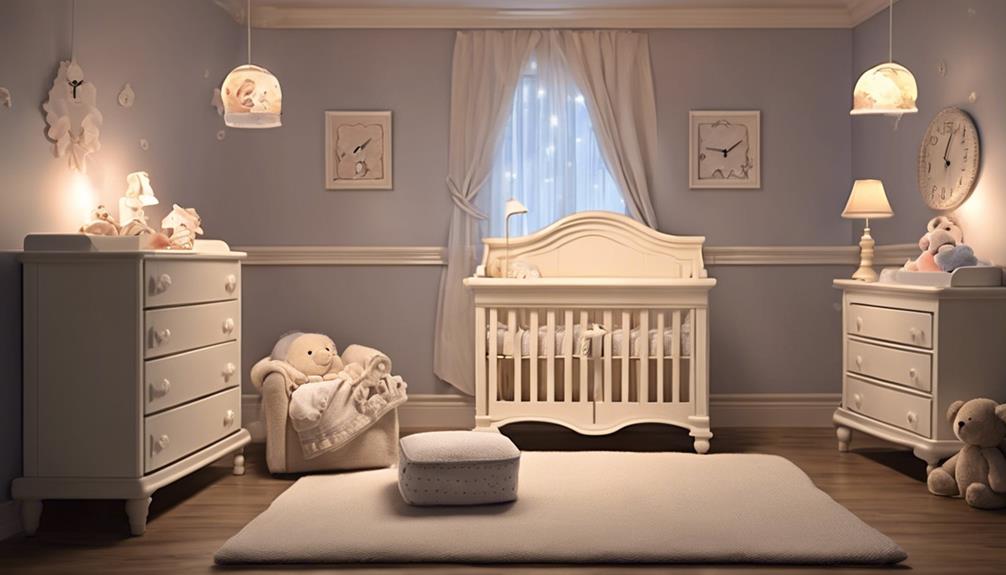Coincidentally, many parents find themselves in the predicament of their newborns preferring the comfort of their arms over a bassinet.
We've discovered some practical techniques to gently shift your little one into embracing the bassinet for sleep.
From establishing a soothing bedtime routine to creating a safe sleep environment, these strategies aim to help your newborn feel secure and cozy in their own sleep space.
Interested in learning more about how to make this shift smoother for both you and your baby?
Key Takeaways
- Create a safe sleep environment in the bassinet with firm bedding and no loose items.
- Establish a consistent bedtime routine to signal sleep time in the bassinet.
- Transition gradually by introducing short naps and encouraging self-soothing.
- Avoid creating strong associations with being held to promote independent sleep in the bassinet.
Importance of Bassinet Sleeping
Choosing to have your newborn sleep in a bassinet is an important step towards guaranteeing their safety and promoting healthy sleep habits. The American Academy of Pediatrics recommends bassinet sleeping as it reduces the risk of Sudden Infant Death Syndrome (SIDS). Placing your newborn to sleep on their back in a bassinet with a firm mattress aligns with safe sleep guidelines, creating a secure sleep space for your little one.
Bassinets are designed to meet safety standards, featuring breathable sides and firm mattresses ideal for newborn sleep. As your baby grows, shifting to a crib from a bassinet can further enhance their safety and comfort during sleep. Addressing any discomfort factors, such as acid reflux or gas, to promote better sleep in the bassinet and guarantee your newborn sleeps soundly.
Common Reasons Newborns Resist Bassinets

When newborns resist sleeping in bassinets, it can often be attributed to their strong preference for the warmth and security of being held in arms. This resistance is a common challenge faced by many parents, but understanding the reasons behind it can help address the issue effectively.
Here are some common reasons why newborns resist bassinets:
- Some babies resist bassinets because they're used to the motion or rocking they experience when held.
- Discomfort from acid reflux or gas issues can make newborns resist sleeping in a bassinet.
- Babies who are overtired may resist the bassinet as they struggle to settle down for sleep.
- Newborns may resist bassinets due to the startle reflex, which can cause them to wake up frequently when placed in the bassinet.
- The new environment of the bassinet may feel unfamiliar and uncomfortable for the baby, leading to resistance.
Understanding these factors can help parents find solutions to encourage their newborns to sleep peacefully in their bassinets.
Creating a Safe Sleep Environment

To guarantee your newborn's safety and promote quality sleep, it is essential to establish a secure sleep environment in the bassinet. Following safe sleep guidelines is vital. Make sure the bassinet has a firm mattress and a fitted sheet to reduce the risk of suffocation. Keep the sleeping area free of blankets, pillows, and stuffed animals. It's recommended by the American Academy of Pediatrics (AAP) to place the bassinet in the parents' room for the first 6-12 months to lower the risk of SIDS. Maintain a room temperature between 68-72 degrees Fahrenheit to provide the best sleep conditions for your newborn. Remember to always follow the AAP guidelines for back sleeping, as this helps reduce the risk of SIDS. Below is a handy table summarizing key points for creating a safe sleep environment in the bassinet:
| Safe Sleep Guidelines | Details |
|---|---|
| Firm Mattress | Reduce suffocation risk |
| Fitted Sheet | Secure bedding |
| Room Temperature | Maintain 68-72°F for the best sleep |
| Back Sleeping | Follow AAP guidelines for SIDS risk |
Establishing a Bedtime Routine

To create a soothing bedtime routine for your newborn and encourage better sleep in the bassinet, focus on incorporating calming activities and creating a peaceful environment conducive for relaxation. Consistency is key in helping your newborn establish a positive association with the bassinet for sleep. Here are some practical tips to contemplate:
- Warm Bath: A warm bath can help relax your baby's muscles and prepare them for sleep.
- Gentle Massage: A gentle massage with baby-safe oil can soothe your newborn and promote relaxation.
- Soft Music: Playing soft and calming music in the background can create a serene atmosphere for bedtime.
- Dim Lights: Dimming the lights in the room signals to your baby that it's time to wind down.
- Quiet Time: Engage in quiet activities before bedtime to avoid overstimulation and help your newborn switch to sleep peacefully.
Transitioning Newborns to Independent Bassinet Sleep

Making the switch to independent bassinet sleep for newborns can be a gradual process that involves establishing consistent routines and encouraging self-soothing habits.
Begin by introducing short naps in the bassinet to accustom your baby to the new sleep environment before moving to nighttime sleep.
Encouraging self-soothing is key; place your newborn in the bassinet when drowsy but awake, allowing them to learn how to settle themselves to sleep.
Consistent bedtime routines, such as a warm bath or gentle lullabies, can signal that it's time for sleep in the bassinet.
It's important to avoid creating strong sleep associations with being held, ensuring that most sleep occurs in the bassinet.
Providing comfort and reassurance in the bassinet through gentle touch or a familiar blanket can help your newborn feel secure and settled for independent sleep.
Conclusion
To sum up, moving your newborn to sleep in a bassinet can be a challenging but rewarding process. By creating a safe sleep environment, establishing a bedtime routine, and using calming techniques, you can help your baby sleep soundly in their own space.
So, why wait? Start implementing these strategies today and watch as your little one drifts off peacefully in their bassinet. Sweet dreams await!









